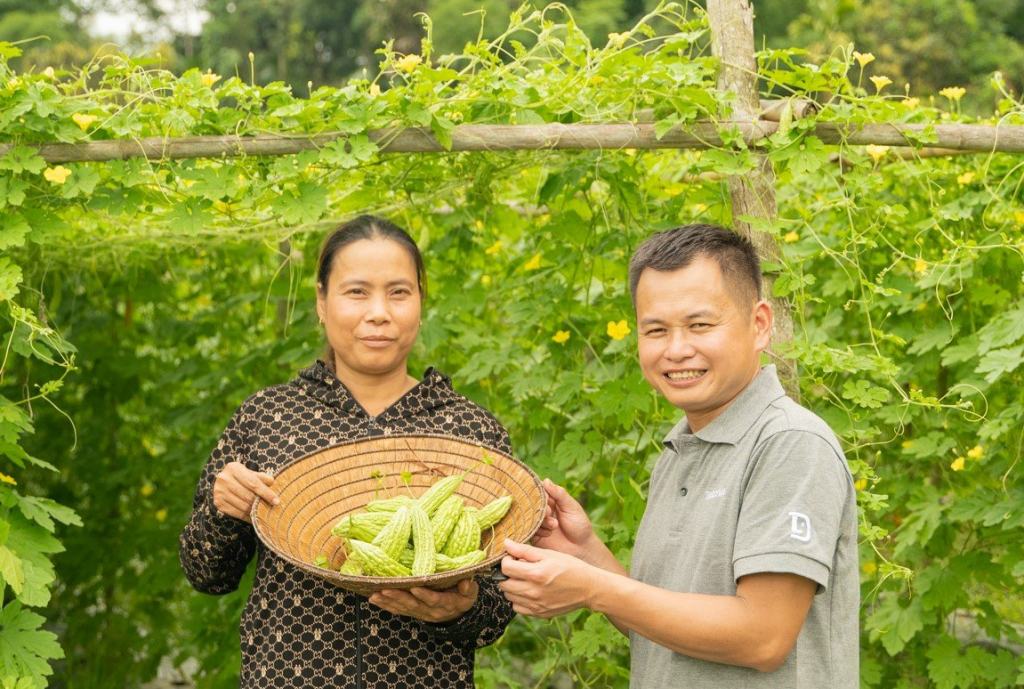When most people think of travel, they see famous landmarks, bustling city streets, and Instagrammable check-in locations. But nowadays, more and more travelers are seeking experiences that offer more than just the typical tourist sights: they’re looking for ways to immerse themselves in local culture, contribute to the communities they visit, and leave a positive impact. Community-based travel provides an incredible opportunity to do just that.
In this article, we explore the growing trend of community-based travel in Northern Vietnam and how it goes beyond sightseeing to create a lasting impact for both the traveler and the local community. Visit places you won’t find on Google and have a positive impact on local communities!
1. What is community-based travel?
Right now you might be wondering: What is community-based travel? Community-based travel (CBT) is a type of tourism that allows local communities to actively engage with and benefit from tourism while still preserving their cultural heritage. In contrast to traditional tourism, where benefits often bypass local communities, CBT ensures that tourism revenue directly supports the people and places that make the destination unique. Let’s dive deeper into the concept of CBT and how it works.
Definition and core principles of community-based travel
- Definition of community-based travel: Community-based travel refers to a type of tourism where the community actively participates in planning, managing, and benefiting from tourism activities. This form of travel emphasizes responsible engagement, environmental sustainability, as well as respect for local culture.
- Core principles of community-based travel:
- Cultural exchange: Travelers are encouraged to interact with local people, learning about their daily lives, traditions, and customs. It’s not just about sightseeing; it’s about learning and sharing too.
- Economic empowerment: CBT allows local communities to directly profit from tourism, fostering the development of small businesses, markets, homestays, etc.
- Environmental sustainability: This tourism model prioritizes minimizing the ecological footprint of tourism, ensuring that local environments and wildlife are preserved for future generations.

Community-based travel vs. Traditional tourism
Community-based tourism places local communities at the center of the tourism experience, ensuring they benefit economically and culturally, while traditional tourism often focuses on large-scale operations and may not benefit local communities directly. The experiences are often surface-level, designed for convenience and mass appeal, and tend to prioritize well-known landmarks over cultural immersion. While CBT promotes sustainability and mutual cultural exchange, traditional tourism can lead to overcrowding, environmental degradation, and limited local engagement, focusing more on profit and the spectacle of sightseeing.
2. Why Northern Vietnam is an ideal destination for community-based travel?
Northern Vietnam is a region that offers the perfect backdrop for community-based travel. From its dramatic landscapes to its rich cultural diversity, this area provides not just a visual feast but also opportunities for meaningful engagement with local communities. Here’s why Northern Vietnam stands out as an ideal destination for this kind of travel:
Rich cultural diversity
Northern Vietnam is home to a vast number of ethnic minorities, with over 20 distinct groups such as the H’mong, Tay, Dao, and others, each with its own language, traditions, and customs. This diversity creates an authentic cultural experience that travelers can engage with directly.
- Cultural experiences: In Ha Giang, you can visit villages where the H’mong people still maintain their ancient practices of weaving textiles, and living in stilt houses. Travelers have the chance to participate in traditional activities like rice planting or attending local festivals like the Buckwheat Flower Festival, or the unique Lunar New Year celebration of Pa Then ethnic minority.
- Local knowledge: These communities often share their traditional knowledge with visitors, whether it’s about local farming techniques, traditional dress-making, or ancient herbal medicine practices.
Breathtaking natural landscapes
From Ha Long Bay’s limestone islands to the majestic terraced rice fields in Sapa, Northern Vietnam’s natural beauty is truly one-of-a-kind. These landscapes are more than just photo opportunities – they all play an important role in the lives of local communities.
- Ha Giang: Known for its jaw-dropping mountain passes and winding roads, Ha Giang is a haven for travelers looking to connect with nature while engaging with local people. Here, community-based tourism allows visitors to experience these dramatic landscapes firsthand by staying in local villages and trekking with ethnic minority guides. Remember to prepare anti-motion sickness medication if you decide to join a motorbike tour through Ha Giang’s beautiful but tricky winding roads, like road to Ma Pi Leng or Bac Sum Slope – as known as the “Heaven Gate”!
- Sapa’s terraced rice fields: The famous rice terraces of Sapa are not just a stunning visual but also the lifeblood of the region’s economy. The rice fields are maintained by local farmers who, through CBT initiatives, have the opportunity to educate travelers about their traditional farming practices and offer hands-on experiences such as rice planting and harvesting.
Authentic travel and cultural immersion
Unlike the more commercialized tourist spots in Vietnam, Northern Vietnam offers a wealth of authentic, off-the-beaten-path experiences. Visitors have the opportunity to stay with local families, participate in traditional activities, and truly immerse themselves in the local way of life.
- Mai Chau: Here, travelers can stay in traditional stilt houses, learn to cook unique authentic local dishes like five-color sticky rice and steamed mountain snail, and engage in handicraft-making workshops with the White Thai people. These experiences help foster a deeper cultural connection and understanding, like those offered by Mango Tiger DMC, an authentic DMC in Vietnam.
- Sapa: In the mountainous regions of Sapa, visitors can trek through terraced rice fields, stay with indigenous ethnic groups like the H’mong, and learn about their age-old farming techniques and vibrant culture. Maybe consider taking a Red Dzao herbal bath to eliminate all of the tiredness after a long day too.
- Ha Giang: Travelers can explore the stunning landscapes of Ha Giang’s winding mountain roads, meet the Tay and Dzao ethnic minorities, and participate in local festivals, providing an enriching cultural exchange.
- Pu Luong: This remote area offers visitors a chance to stay in traditional wooden houses, engage in farming activities, and learn about the spiritual beliefs of the local people through traditional festivals like White Thai people’s Then Kin Pang.
These immersive experiences, away from the typical tourist trail, allow travelers to connect with local communities, engage in meaningful cultural exchanges, and gain a more profound understanding of life in Northern Vietnam.
3. How community-based travel in Northern Vietnam creates a lasting impact
Community-based travel isn’t just beneficial to travelers—it brings substantial, long-lasting benefits to local communities. From economic empowerment to cultural preservation, CBT is reshaping the way tourism impacts Northern Vietnam. Explore the lasting positive effects of CBT on local communities.
Economic impact: Empowering local communities
By choosing community-based tourism, travelers help boost the local economy in sustainable ways. Rather than large corporations reaping the rewards of tourism, CBT ensures that profits stay within the community.
- Homestays and local businesses: Local families in areas like Sapa and Mai Chau rely on income from tourists who stay in their homestays or purchase handmade goods. This income often supports entire communities, allowing families to improve their standard of living. Discover some nice and tidy local homestays in Sapa.
- Mango Tiger DMC’s guided tours in Ha Giang provide opportunities for local guides to showcase their heritage, offering a source of income and promoting local culture. The tourism revenue from these experiences is funneled directly back into the community, helping to fund education, healthcare, and infrastructure improvements. Check out further information in our Youth Brochure here.
Preserving cultural heritage: Protecting traditions
CBT helps protect and preserve local traditions, which might otherwise be lost in the face of globalization. When local people share their traditions with travelers, they ensure that these cultural practices are passed down to future generations.
- Traditional crafts: In Ha Giang, local H’mong women are keeping textile weaving alive. By selling their handmade goods to tourists, they not only earn a living but also preserve an important cultural practice that dates back centuries.
- Cultural exchange: Travelers who engage in local customs—such as cooking, farming, or attending cultural ceremonies help keep these practices vibrant.
Environmental sustainability: Protecting the landscape
Community-based travel also places a significant emphasis on environmental sustainability. Local communities are encouraged to maintain their surroundings in a way that supports long-term ecological balance.
- Sustainable farming and eco-tourism: Local farming practices in regions like Sapa and Mai Chau are often based on sustainable, traditional techniques. CBT helps ensure that these farming methods continue by involving tourists in the process, such as working alongside local farmers during rice harvests.
- Mango Tiger DMC’s eco-tours: Mango Tiger offers eco-tours in Northern Vietnam, encouraging sustainable tourism practices that minimize the environmental footprint of travelers. These tours promote responsible travel while benefiting both the local community and the environment.
4. Off-the-beaten-path festivals & activities in Northern Vietnam
While Northern Vietnam is well-known for its major tourist attractions like Ha Long Bay and Sapa, there are numerous off-the-beaten-path festivals and activities that allow travelers to experience the region’s culture in a more intimate and unique way. Below are some hidden gems that embody the true essence of community-based travel.
Festivals & traditions
- Gau Tao Festival (Bắc Hà)
- Unlike the well-known Tết celebrations in Sapa, the Gau Tao Festival in Bac Ha is a more local and intimate experience. Held during the Lunar New Year, this event is a traditional ritual of the H’mong people, where they perform ceremonies to pray for good harvests, health, and prosperity. The festival features colorful dances, vibrant costumes, and lively music.
- Impact: The Gau Tao Festival helps preserve H’mong traditions and supports local artisans, while giving travelers a unique chance to participate in a centuries-old cultural celebration that is rarely seen by outsiders.
- Khau Vai Love Market (Ha Giang Province)
- Held in the remote Ha Giang region, the Khau Vai Love Market is a centuries-old tradition where people from different ethnic groups gather to meet and celebrate love. It’s a rare opportunity to experience the emotional and cultural richness of the local communities.
- Impact: The event supports local artisans and provides a rare glimpse into the lives and customs of the ethnic minorities in this region.
Off-the-beaten-path activities
- Trekking to the Northernmost Point of Vietnam (Lung Cu Flag Tower)
- Located in Ha Giang, Lung Cu is the northernmost point of Vietnam. The trek to this area offers stunning views of the countryside and an opportunity to learn about local traditions and history.
- Impact: Local guides who lead trekking tours through these mountainous regions directly benefit from tourism.
- Traditional cooking classes in Mai Chau
- Engage with local chefs and learn to prepare traditional dishes from the White Thai people in Mai Chau. This experience provides insight into the agricultural practices and food culture of the region.
- Impact: These classes provide sustainable income for local families while helping preserve traditional cooking techniques.
Through these lesser-known festivals and activities, Northern Vietnam offers travelers the chance to experience the region in a unique and authentic way, while supporting local communities and helping preserve their rich cultural heritage.
5. A new era of travel
Community-based travel offers a transformative way to experience Northern Vietnam while making a positive impact. By choosing responsible tourism operators, staying in local accommodations, and participating in cultural exchanges, travelers can contribute to preserving the environment, empowering local communities, and protecting cultural heritage.
As you explore the captivating landscapes and rich cultures of Northern Vietnam, one of the most rewarding ways to engage in this kind of travel is by partnering with experienced and ethical tour operators, such as Mango Tiger DMC.

Mango Tiger DMC: Your partner in meaningful travel
Mango Tiger DMC stands out in the realm of community-based tourism in Vietnam thanks to several distinctive qualities:
- Authentic, immersive experiences: Mango Tiger DMC specializes in offering deep cultural immersions, ensuring travelers get more than just a surface-level glimpse of Northern Vietnam. Whether it’s staying with ethnic minority families, participating in traditional cooking classes, or trekking to remote, off-the-beaten-path locations, every journey is designed to foster genuine cultural exchange.
- Sustainability at the core: Sustainability is central to Mango Tiger’s philosophy. Their tours are carefully crafted to reduce environmental impact, support local businesses, and preserve cultural heritage. They emphasize eco-friendly practices and responsible travel, making sure that every traveler leaves a positive footprint on the communities they visit.
- Local expertise and personalized service: The team at Mango Tiger DMC consists of local guides with deep knowledge of Northern Vietnam’s traditions, history, and landscapes. Their personal touch ensures a tailor-made travel experience that is uniquely suited to your interests, whether you’re looking for adventure, culture, or relaxation.
- Supporting local communities: With Mango Tiger DMC, the revenue generated from tourism stays within the community. Their tours prioritize homestays, locally-owned businesses, and authentic, community-driven experiences that directly benefit local populations.
- Award-winning itineraries: Mango Tiger DMC has crafted some of the most highly acclaimed travel itineraries in Vietnam. Their tours are thoughtfully designed to showcase not only the major highlights of the region but also the hidden gems that are often missed by conventional tourism. Their 4-day Ha Giang motorbike tour and 11-day Vietnam Express North to South adventure, for instance, are perfect examples of how Mango Tiger DMC provides an unforgettable, all-encompassing journey through Vietnam’s landscapes and communities.
Are you ready to go beyond sightseeing and make your travels meaningful? Let Mango Tiger DMC be your guide in Northern Vietnam, where adventure meets cultural immersion and responsible tourism creates lasting impact.
Contact Mango Tiger DMC today to start planning your journey and experience the true heart of Vietnam. Whether you’re looking to hike through the breathtaking hills of Ha Giang, explore the deep cultural traditions of Sapa, or immerse yourself in authentic community-based experiences, Mango Tiger DMC is your trusted partner in responsible travel.Get in touch with us now at info@mangotiger.com or visit www.mangotiger.com to learn more about our tours and book your next adventure.

